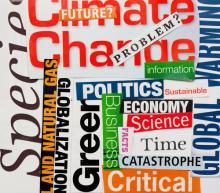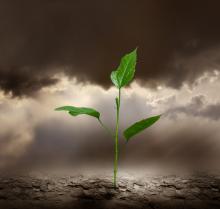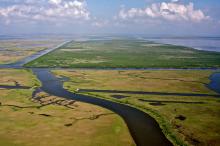Environmental Stewardship

IN EARLY JUNE, a team of prominent biologists, ecologists, paleontologists, and climatologists published a long article in our most important scientific journal, Nature. It concluded that people have so disturbed the operations of the planet that it is nearing—perhaps within decades—a “state shift” to a new biological paradigm unlike any human civilization has ever encountered.
“It really will be a new world, biologically, at that point,” warns Anthony Barnosky, professor of integrative biology at the University of California, Berkeley, and lead author of the study. “The data suggests that there will be a reduction in biodiversity and severe impacts on much of what we depend on to sustain our quality of life, including, for example, fisheries, agriculture, forest products, and clean water. This could happen within just a few generations.”
For many of us who have long studied these questions, there’s nothing that surprising in the conclusions. I mean, we’ve already put enough carbon in the atmosphere to melt 40 percent of the summer sea ice in the Arctic, to make the ocean 30 percent more acidic, and to turn the atmosphere 5 percent wetter, thus loading the dice for drought and flood.
What’s surprising is not the science. It’s the endless lack of reaction to it. The secular press barely covered the Nature study—The New York Times discussed it in a blog post, not in the paper. And I didn’t hear any reaction at all from the nation’s clerics, though it strikes me this kind of story strikes much closer to the heart of our theology than most of the things we do hear clerics opining about. Contraception? Okay, sort of, you can kind of find something about it in the Bible. Homosexuality? The occasional passing reference. But the whole first page of the thing is about nothing but creation, the fact that God made everything around us, pronounced it good, and told us to take care of it.
From The Guardian:
The Gulf of Mexico oil spill continues to plague BP more than two years after the disaster as the company has revealed another $847m (£538m) hit to cover rising legal costs.
The additional charge for the second quarter brings the total bill for the fatal Deepwater Horizon incident to $38bn, BP said.
BP is struggling to shake off the reputational blow of the April 2010 Macondo blow-out after recently coming under further fire in a report from a US government safety panel.
Learn more here

Whether churchgoers realize it or not, the trees in their churchyards have religious roots.
Those tall, thin-branched trees on the corner of this city's Episcopal Church Center of Utah, Purple Robe Black Locusts, were probably named after a biblical reference to John the Baptist eating locusts and honey.
Nearby, the crab apple tree just outside the Episcopal Cathedral Church of St. Mark produces a small, sour fruit used by 15th-century monks to treat diarrhea, dysentery, and gallstones.
And the flowers of a nearby dogwood tend to bloom around Easter.
“My hope,” said University of Utah biology professor Nalini Nadkarni, “is [worshippers] will realize that nature and trees are as much a part of their sacred ground and worthy of reverence as what goes on inside a cathedral or church.”
Writing for The Huffington Post, Joanna Zelman reports on a new NASA study:

Good news: Evangelical Christians are stepping back up to overcome the climate crisis.
After months of careful preparation, a new national advocacy initiative called Young Evangelicals for Climate Action (Y.E.C.A.) has just gone live.
In seeking to live as Christ’s disciples, Y.E.C.A. has come to see the climate crisis not only as a pressing challenge to justice and freedom, but also as a profound threat to “the least of these” with whom Jesus identifies in Matthew 25. The early effects of climate change are already impacting many of our neighbors, both in the U.S. and around the world, and our time to act is running short.
Mother Jones examine the growing phenomenon of urban farms, and the effects that they are having on their communities:
"There's been a growing body of research that suggests that urban farming and greening not only strengthen community bonds but also reduce violence. In 2000, Philadelphia had 54,000 vacant lots, and so the Pennsylvania Horticultural Society reclaimed 4,400 of them, mowing lands, providing upkeep, planting trees and gardens, and erecting three-foot-high fences that served no purpose other than as a kind of statement that this land now belonged to someone.
The greening of these parcels (just 8 percent of the vacant land in the city) had an unexpected effect: Over the course of 10 years, it reduced shootings in the areas surrounding these renewed lots. Part of it was practical: The vacant lots had previously been hiding places for guns. But as Charles Branas, an epidemiologist at the University of Pennsylvania who released a study on the project late last year, says, 'People just became more in touch with their neighbors. People felt more connected to each other.'"
Learn more here
For The Daily Beast, Mark Hertsgaard asks why parents aren't taking the potential effects of climate change on their children's lives more seriously:
"Beyond the distress and discomfort, the record-breaking heat raises a puzzling question for anyone who cares about the future of our young people. The laws of physics and chemistry—the fact that carbon dioxide remains in the atmosphere for decades after being emitted—mean that man-made global warming is just getting started on this planet. As a result, my Chiara and millions of other youth around the world are now fated to spend the rest of their lives coping with the hottest, most volatile climate in our civilization’s 10,000-year history. Think of them as Generation Hot.
Why, then, are so few parents taking action to try to protect their beloved children from this gathering catastrophe? And why has no one asked them to?"
Learn more here
Bill Nye the Science Guy may not be a real scientist, but he tells CNN's news anchor that he knows how to read a chart, and when you look at the data on climate change, journalistic objectivity shouldn't try to obscure the facts. Watch Nye respond to climate change skeptics and discuss the conditions that led to the Colorado wildfires. [via CNN]

Rest and renewal are hard to come by for any leader.
As such, there’s a week that I treasure each year for providing me with the deep replenishment I need to keep me going as I lead international creation care ministries. It may not be everyone’s idea of a good time, but for me it’s a balm that picks me up like no other—Duke Divinity School’s annual summer institute hosted by the Center for Reconciliation.
The first time I attended the institute in 2010, I limped in like a spent marathon runner crossing the finish line. After successfully rising to the challenges of the recently ended academic year, I was bone weary from the demands of leadership and ready for a week of recuperation and rejuvenation.
I was looking forward to being with like-minded leaders who implicitly understand my mission to educate Christian university students to “be agents of, and participants in, God’s shalom,” soaking in the wisdom from long time heroes like John Perkins, and participating in my selected creation care track led by Duke Divinity’s Norman Wirzba.
Salon reports on a new study which suggests that "fracking" can pollute water sources:
"A new study, published in the formidable Proceedings of the National Academy of Sciences, upends that common-sense argument. It shows that fluids may have traveled from deep within Pennsylvania’s Marcellus Shale, one of the formations at the center of the gas boom, into shallow aquifers hundreds of feet above. These fluids aren’t products of fracking, but if they can travel up through layers of rocks, close to the surface, it means that fracking fluids could, too."
Read more about the study here
According to the Atlantic Cities, lawmakers in North Carolina have chosen to ignore studies that show sea levels are rising faster than previously expected in favor of developing new housing along the coast.
According to the rerport, state Rep. Pat McElraft, a not-scientist, said in a floor debate that the state should assume sea levels will rise at the same rate they have in the past: 8 inches over the past century.
From Kelly Henderson's Switchboard blog post:
"The scientific findings that North Carolina coasts will likely experience a 39-inch sea-level rise created quite a stir and were challenged by NC-20, a coastal economic development group, who cited flaws in the research. The group fears losing dollars if coastal planning begins now to prepare for the 39-inch rise since over 2,000 coastal miles will become restricted to development."
And, from Mr. Colbert, on N.C.'s logic in only considering historical data:
"If we consider only historical data, I've been alive my entire life. Therefore, I always will be."
Sandi Villarreal is Associate Web Editor for Sojourners. Follow her on Twitter @Sandi.

In huge news last week that was largely overwhelmed by the Supreme Court ruling on health care, Washington came together to direct the Clean Water Act fines from BP's oil drilling disaster of 2010 to fund Gulf coast restoration and recovery.
Attached to the transportation bill that President Obama signed on July 6 was a provision called the RESTORE (Resources and Ecosystems Sustainability, Tourism Opportunities and Revived Economies) the Gulf Coast Act, which will send 80 percent of BP's eventual fines (likely somewhere between $4-$20 billion) to the five Gulf states and set up an ecosystem restoration council with joint state and federal leadership.
Faith communities should cheer this news for a couple of reasons. First, they asked for it. The legislation has been supported by many different faith-led efforts, such as a letter signed by over 140 religious leaders from Sojourners own Jim Wallis, Mitch Hescox of the Evangelical Environmental Network, and many clergy from around the nation. Local Gulf faith leaders spoke up as well, with the Louisiana Interchurch Conference passing a resolution calling on their member groups to support and lead efforts for Gulf recovery and the RESTORE Act.

Sister Kathy Long turned toward my 13-year-old daughter and asked one question: “What will you tell your friends about spending this month in Mexico?”
In a public park in Cuernavaca, Mexico, we sat on a concrete bench next to six women who chatted and stitched embroidery patterns with brightly colored thread.
I glanced toward the sewing group, realizing that Maya would have rolled her eyes if I had asked her that same question. An intrusive query from a mother seemed compelling coming from a Catholic nun who worked in Mexico, promoted justice amid poverty, and even spent three months in jail for protesting the military training of Latin American leaders in the U.S.
“I will tell them that rich people and poor people are all people in the end,” Maya responded. “If you have three cars and two houses, you are a person just like someone whose house is made of cardboard or metal.”
The Atlantic profiles a new documnetary called Bangladesh: On The Frontlines of Climate Change:

Please don’t sweat the 2,132 new high temperature marks in June — remember, climate change is a hoax.
The first to figure this out was Oklahoma Senator James Inhofe, who in fact called it “the greatest hoax ever perpetrated on the American people,” apparently topping even the staged moon landing.
But others have been catching on. Speaker of the House John Boehner pointed out that the idea that carbon dioxide is “harmful to the environment is almost comical.” The always cautious Mitt Romney scoffed at any damage too: “Scientists will figure that out 10, 20, 50 years from now,” he said during the primaries.
Still, you have to admit: for a hoax, it’s got excellent production values.

Church camp was in my blood, with an Episcopalian lineage that began when my grandfather helped to build and then direct Camp Bratton-Green in Mississippi. Every summer of her childhood, my mother was a camp brat, the outdoorsy, lanyard-loving equivalent of an army brat.
As a 16-year old, she met my father when he drove his family’s car from Hattiesburg, Miss., to pick up his sister Marcia from camp in Canton, Miss. And decades later, two of my siblings met their spouses at camp.
But let’s be clear: church camp in my family was more than an easy way to find a summer fling from the same denomination. While none of my crushes lasted beyond the summer, I gained a more enduring life-long commitment to God’s earth. Summer camp integrated me into a Christian community that sought to reconcile humans with creation.

The Colorado wildfires are raging this week. I’m in Denver, and the grey haze over the mountains in the distance gives me a sick feeling. Countless trees on hundreds of thousands of acres have gone up in smoke. Hundreds of homes have been destroyed. Even human lives have now been forever lost to the flames. It’s tragic, and it’s not over yet.
But here’s what I believe. One day, when these fires have been extinguished, this land will be restored. People will do whatever it takes to reforest these hills and rebuild their homes. In a few years, mountainsides that are charred and blackened today will be green again. We have the will and the resources to restore our environment when it has been destroyed.
Two weeks ago I was in Haiti. Unlike the deforestation that has happened in Colorado in a matter of days, Haiti’s 98-percent deforestation has happened over centuries. The destruction to Haiti’s natural environment is almost complete. Birds are rare. Small animals are almost gone. Fish that once teemed in the waters around the island are barely there.
It gets worse.
CHOOSING TO PAY more for a gallon of gas than the price at the pump sounds a bit crazy—but that is exactly what a couple of dozen members of the Community of St. Martin, a worshipping group of Lutherans, Catholics, Mennonites, and others in Minneapolis, Minnesota, have covenanted for more than a year. It’s one way they’re seeking to show commitment to environmental stewardship.
After committing to a voluntary “tax” rate (from $1 to $3 per gallon, depending on income), each community member keeps track of gas receipts. The Community of St. Martin (CSM) collectively decides in advance how their taxes will be spent each quarter. Every three months, the group gathers to write checks and conduct a lively discussion about changes in their gasoline usage habits. CSM borrowed the idea from a group in Goshen, Indiana, that started a similar campaign 10 years ago.
Why intentionally pay more for gas than it costs? According to CSM members, this is precisely the point: The price of gas in the U.S. doesn’t reflect the actual costs that U.S. society and the global community incur as a result of the country’s dependence on oil. Those costs include fossil fuel’s contributions to air pollution and global warming. Also hidden at the pump are the costs of U.S. strategies to maintain an inexpensive supply of oil, often through political or military interventions in oil-producing regions—not to mention $4 billion a year in tax credits and subsidies to Big Oil.
Sara Nelson-Pallmeyer, the group’s treasurer, says that “everyone is paying a different amount—from $10 to $385 per month. The fun part is that so far we’ve given more than $5,000 to organizations working on alternative transportation solutions and advocating for political change around climate-change issues.” She added that, ironically, “The real heroes of the group are the ones paying the least.”
In the final part of its series on evangelicals and climate change, The Christian Post's Napp Nazworth writes:
"Global warming skeptics argue that while global warming activists say that reducing carbon dioxide emissions is necessary to protect the poor and vulnerable, the science is so iffy and the cost of control so high that money would be better spent on direct aid to the poor."

How do you know when someone has a Prius?
Don’t worry; they’ll tell you.
We got a Prius about four years ago, and immediately we bought into the hype about milking every gallon of gas for another tenth of a mile. We read the hyper-miler blogs about how to employ the gas and brake pedals most efficiently. We competed against each other for the best MPG. It was nerdy but fun, and we felt like we were doing something at least a little bit socially redeeming.
I haven’t seen the research, but I’m convinced that a significant chunk of the Prius’ reputation as a gas miser stems from the way its users are trained to drive it.